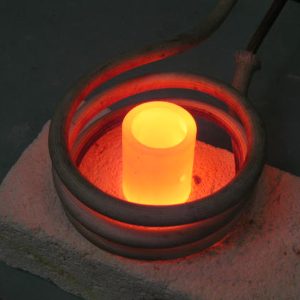Consider the Energy Efficiency of Induction Heating for Melting Applications
 In every manufacturing or industrial engineering business, energy efficiency is a critical variable for understanding how successful your operation may be in the broader marketplace. This is one reason why induction heating equipment is on the rise in manufacturing facilities across the globe.
In every manufacturing or industrial engineering business, energy efficiency is a critical variable for understanding how successful your operation may be in the broader marketplace. This is one reason why induction heating equipment is on the rise in manufacturing facilities across the globe.
The precision and efficacy of induction heating are picking up great interest among engineering teams engaged in metal melting applications. In this article, we will outline how engineers can harness this technology’s energy-efficient attributes to optimize processes, reduce costs, and enhance the sustainability of their operations.
A number of industries require melting work to manufacture products of all sizes: foundry and metal casting, automotive, aerospace, manufacturing and machinery, electronics, jewelry and precious metals, medical devices, energy and power generation, metal recycling, and research and development laboratories.
Let’s take the automotive industry as an example. Consider the molten metal poured into molds for sand casting applications (to produce engine blocks, cylinder heads, and transmission housings, for instance).
Here’s what your team can achieve with induction heating equipment for your metal melting applications.
And one last note: Melting may be just one facet of your broader manufacturing needs, but it’s a great place to begin to understand the efficiencies of induction heating.
Cost Savings
The manufacturing arm of the automotive industry often operates on tight budgets, and energy costs can be a significant portion of their overall expenses.
Energy-efficient induction melting processes help reduce operational costs, making production more economically viable. Induction heating presents these low-cost expenses in contrast to ovens or furnaces, which must run all day long to keep the specific temperature.
To better grasp your existing costs, you must understand the specific costs related to the different materials you are melting in your facility. There may not be a radical degree of variability between, say, light scrap aluminum or ductile iron, but you’ll want to scrutinize costs carefully and with an eye toward your specific application.
Engineers can implement energy-efficient induction heating by optimizing equipment design, selecting efficient power sources, and employing insulation and heat containment measures to minimize heat loss.
A More Positive Environmental Impact
In our era of greater environmental awareness and more stringent regulations, minimizing energy consumption is essential for reducing the carbon footprint of industrial operations. Energy-efficient melting processes produce fewer greenhouse gas emissions and contribute to a more sustainable manufacturing approach.
WANT TO LEARN MORE ABOUT MELTING APPLICATIONS? GET IN TOUCH TODAY
Because induction heating equipment targets the metal (or other material) directly, heat loss is minimized, and thus your facility’s carbon footprint is minimized.
As new projects or budgets come along, engineers can scout energy-efficient induction heating equipment. This is not a snap-your-fingers process, but naturally a manufacturing facility will provide opportunities to upgrade equipment and implement induction heating technology moving forward.
Bonus tip: Even beyond the induction heating equipment itself, your facilities team can check the building’s insulation and perhaps implement a more effective material.
Process Sustainability
Energy-efficient melting processes align with sustainability goals, demonstrating a commitment to responsible manufacturing practices. This can be a significant factor in meeting regulatory requirements and customer expectations for sustainable products. Induction heating systems employ solid-state electronic components, such as insulated gate bipolar transistors (IGBTs), inverter circuits, and digital control modules; this is important because those components, being semiconductor devices, have no moving parts. They’re reliable over time.
This helps your maintenance needs, too.
Through the analysis of real-time data, predictive maintenance algorithms can anticipate equipment degradation or failure, allowing engineers to schedule maintenance activities precisely when needed. This approach maximizes system uptime while reducing unplanned maintenance events.
Engineers should prioritize the selection of energy-efficient equipment, conduct energy audits to identify areas for improvement, and invest in employee training for energy-conscious operation.
Competitive Advantage
Industries are continually seeking ways to remain competitive. Energy-efficient operations can lead to cost advantages, improved profitability, and a competitive edge in the market. Take all of the points we’ve offered so far and think about them through the lens of your market competition.
With thin margins, depending on broader market conditions, any edge you can gain by implementing induction heating technology is a big leap forward.
Engineers should continually seek innovative technologies and process improvements to maintain or gain a competitive advantage through energy efficiency. Process control is paramount! Induction heating is a great place to implement tighter controls up and down your facility.
Increased Energy Availability
In some regions or during peak demand periods, energy availability may be limited or costly. This pool of resources is constantly in flux. Energy-efficient melting processes can help industries better manage their energy needs, reducing the impact of energy shortages or high prices.
Engineers can implement load management strategies, such as shifting energy-intensive processes to off-peak hours, to optimize energy usage.
Let’s be clear: Energy efficiency in induction heating transcends mere cost-cutting; it presents a multifaceted challenge that addresses environmental stewardship, resource conservation, and the optimization of complex industrial processes.
When you’re melting metal, every edge you can gain on your competitors counts.
WANT TO LEARN MORE ABOUT MELTING APPLICATIONS? GET IN TOUCH TODAY